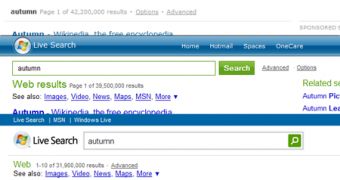Starting mid-April, Microsoft has introduced the new stage in the evolution of Live Search. The release affected not only the core Live Search engine, but also additional components of the Redmond company's web search services including News, Video, and Products. The revamped search experience is not limited to an under-the-hood evolution, as Evan Malahy, Designer, Live Search revealed, also featuring relevant changes in terms of design. Placing a strong focus on design as a critical aspect of the search product, Microsoft has labored to make the new Live Search simple and powerful, human and fast.
"Simple and powerful is about getting just enough, having information and tools when you need them, and revealing functionality without being overwhelmed," Evan Malahy revealed. "Being human reminds us that all good products speak to people and we should always design for them. Being fast has particular relevance to search where so much depends on rolling up the world of information to support people's countless other activities and passions."
There is no question that Microsoft indeed managed to move forward with the design of Live Search, and that, in the end, this will reflect on an enhanced user experience. Still, the company needs to focus first of all on the core search engine and later on the surface. In comparison to Google, Live Search is by no means limping in terms of design, but in its ability to accurately connect the end user with information and to exhaustively index content on the web. Otherwise, end users will be able to identify changes introduced to the search box near results, the page's layout, fonts, video search etc.
"The new Live Search header and search box is slimmed down from a heavy piece of UI into sleeker, simpler elements. Bringing the search box into alignment with the results and into the body moves it closer to where users are looking and flattens out the visual bumps between it and the results. Something else you'll see on a large screen (lucky you!) is our centered, fixed-width page, allowing for a more thoughtful, predictable experience as richer search content and wider screens become the norm," Malahy added.

 14 DAY TRIAL //
14 DAY TRIAL //